Interview with SIX
 Array
Array
Two weeks ago I had the great pleasure of interviewing five jewelry artists: Marcin Tyminski, Bogumił Bytomski, Arek Wolski, Paweł Kaczyński and Krzysztof Roszkiewicz, who in 2001 founded an artistic group, with a catchy name, SIX.
It is one of the most interesting groups of this type active in Poland. Not only could their exhibitions be watched in many cities in our country, but also in the United Kingdom and Norway. For several years, this group have also awarded their prize at an international festival SILVER in Legnica.
Why is it worth to read an interview that I have prepared for you? First and foremost, because so far no one from the Polish press have paid enough attention to the mentioned artists – and they certainly deserve it. Secondly – this group have raised some very interesting subjects, and despite their internal diversity, and the amassment of strong personalities – they managed to create an integrated, extremely eloquent work, which is an art in itself.
As far as technical issues are concerned, due to the fact that during the interview the men talked simultaneously at times, mutually finishing each other’s sentences, I decided to mark who said particular sentences only in those places where it actually mattered. I hope that it will not make the text more difficult to read. I will be grateful for any feedback on this topic.
Without further delay, I encourage you to read the interview. Let me start the article with an opening quote, which can also be considered to be the motto of the SIX group.
Why SIX group?
– Because we like it
– Because we can
– Because we care
… And we cry out for acclaim
1. When and under what circumstances was the group SIX set up? Why such a name?
It started with Paweł and Marcin’s trip to Łódź. We had an idea that it would be fun to create a group of jewelry artists whose artistic styles were completely different. There were not too many exhibitions and this type of activities, so we thought that it was the right time and place.
Obviously, we needed a name for the group. During the meeting at Bogus’s, which took place after the exhibition in Rybnik, we were brainstorming to decide on something. Different names were suggested, but none met with the approval of the majority, and finally someone said: “For me, it could be anything, any name, it can even be SIX” – and it caught on.
2. Where did the meetings of the SIX take place?What happened during them?
The meetings took place mainly at Bogus’s. He had such a nice, round table in the kitchen and cooked good, vegetarian food. Discussions were so heated that after some of them we often thought that our group had just fallen apart. And after a while it turned out that it was quite the opposite – we came up with a new theme for the exhibition. Brainstorming is a very apt description of what our meetings looked like – it was always a very animated debate and although nothing serious has ever happened, there were cases of grabbing each other by the collar a couple of times.
3. You claim that the exposition of the display should be an integral part of jewelry taking part in the exhibition – why is it so important?
Exhibitions were, in a way, determined by the space in which they were held. In all of our exhibitions a quite important principle was that we agreed exactly on how we wanted to present the display – but to the last minute, before the opening, none of us knew the work of the other person. We determined the theme of the exhibition and the work had to fit the topic as much as possible, the rest depended only on our imagination.
We did not have the experience, at least at the beginning we were floundering around, everything by trial and error. We liked to go with the flow, we had lots of ideas and we tried to pursue them as best as we could. At the beginning we had no catalogs, well, we had nothing, actually. What we created was mostly one night happenings. It took us 10 years to gain the experience – we learned something new with every project.
4. Can you discuss several exhibitions in detail?
GOLD was a very interesting exhibition. Only 5 works were presented there and if not for the exposition, the exhibition itself would not make sense. In addition, the GOLD started a new path in the method of presenting the works, at least for Polish standards. After this exhibition, the artists from the community started to go out of the their armored showcases, in which they had been locked so far. I still remember well how much effort people put to come up with some aesthetic lock to the display cases.
Each of the five works at the GOLD exhibition was presented on a low pedestal, lying on the floor. A flashlight was hung under the ceiling emitting a spot of light illuminating one item – and it was the only source of light in a dark room. As guests entered the gallery, at the beginning it was clear that they did not know what to do. Only after a little encouragement did people dare to approach the works, which could be seen only by the aforementioned beams of light. First, however, one had to kneel down to even pick up the jewelry…
Another interesting exhibition was DESIGN – it was one of the first exhibitions in Poland based on computer 3D object printing technology (it was in 2007). Boguś was the only person among us who had knowledge about computer programs. So he sat down with us and took a digital copy of the ring, which we designed together. In this way, a prototype was created, which then was printed out and cast in several copies. Each of us got 4 the same casts, rings, on the basis of which we had to do something new, entirely in our own way. In this exhibition, the most interesting was the process of creating the ring and the fact that we did it on the basis of new technologies which were little known then..
The exhibition DESIGN is an attempt to comment on the contemporary design. Currently visible, strong growth in this area is the result of high demand of the industry for well-designed items, used by a mass consumer. This situation does not, however, result in the numerous new ideas, but rather in setting trends which are followed by the competing manufacturers. The differences between the offered products actually boil down to putting your own logo and this applies both to cars and jewelry.
– Group SIX, 2007
- Arek Wolski
- Arek Wolski
- Arek Wolski
- Arek Wolski
- Krzysztof Roszkiewicz
- Krzysztof Roszkiewicz
- Krzysztof Roszkiewicz
- Krzysztof Roszkiewicz
- Marcin Tymiński
- Marcin Tymiński
- Marcin Tymiński
- Marcin Tymiński
- Paweł Kaczyński
- Paweł Kaczyński
- Paweł Kaczyński
- Paweł Kaczyński
- Bogumił Bytomski
- Bogumił Bytomski
- Bogumił Bytomski
- Bogumił Bytomski
For us, it was a kind of a masterpiece to combine the theme, the way of exhibiting and of course the jewelry itself. It is important that these three elements form a coherent whole. In the case of the exhibition IN THE FACE OF, each of us chose one, interesting for him, a theme (2πr, Relaxation, Entropy, Family, Her), and then tried to answer on each of them with the help of jewelry. The interesting thing was that we knew how to answer our own topic, but to relate to the friend’s topic required a further thought. In this way a very fascinating exhibition was created based on several points of view.
5. What drove you to act? Why did you want to organize exhibitions?
After the exhibition in Rybnik we were shocked that you could do something so cool and you did not actually need a lot to make it happen. We came to the conclusion that if we gathered together a group of 3 or 4 people, every year it would be easier to prepare an exhibition of unique objects on a satisfactory level for us. It was great to collide with such different styles and points of view on a similar subject.
It did not mean, however, that in the meantime we were not doing individual exhibitions. Members of our group were not haphazard, each of us was doing something, had had certain achievements. We were looking for someone who worked a little beyond producing items for sale – someone who took part in competitions and exhibitions. What drove us? It was cool that we did not have to be limited only to participating in organized at the time competitions and exhibitions of jewelery but we could create something of our own, on our own topics that we wanted to raise, and that interested us much more.
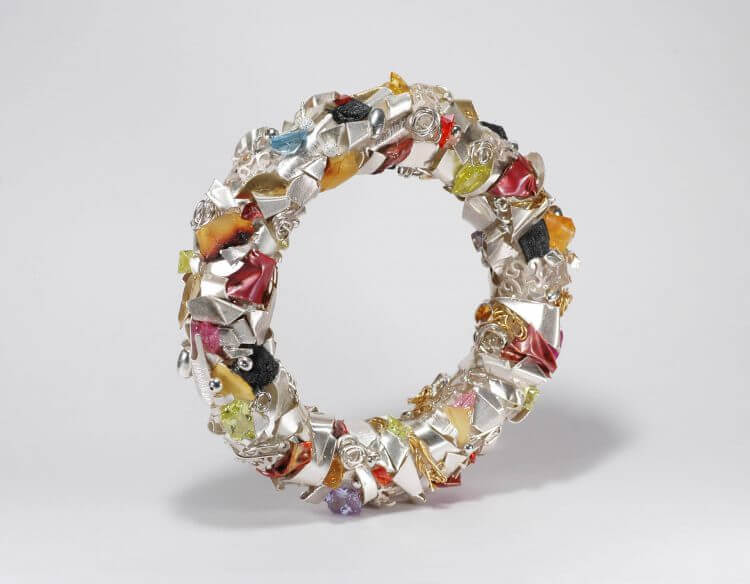
Author: Krzysztof Roszkiewicz, “Jewellery must be beautifull, if not intelligent at least” exhibition
6. Is it more difficult to annoy or delight an adult, a mature artist? I’m asking this because you have not done anything together for a long time. Has the world ceased to be interesting?
P. Kaczynski: We have operated very actively for 10 years, generally we could go on … it has been fulfilling and maybe we are a bit fulfilled now . It is not so that we no longer want to work – we are simply more occupied by other things in life nowadays
A. Wolski: Many of our exhibitions resulted from anger or delight – it was about things that were puzzling or upsetting to us. There were issues among these topics that each of us was trying to unravel, some of them affirmative, some stemming from anger. There are still issues that move us. It is not that the world no longer concerns us. We still make jewelry, we react to what surrounds us – just not together anymore.
7. If you could go back in time – would you have devoted your life to jewelry making?
B. Bytomski: Personally, I like doing it and I still want to do it.
M. Tyminski: I also like doing it
A. Wolski: I think that it is a question connected to time. When we were beginning, the status of jewelry was totally different. Because now it is some kind of a hobby for girls –in the past there wasn’t jewelry that now can be bought on all these portals. There used to be a designer and jewelry was designed . This position was very low compared to other applied arts, nevertheless it was of some importance and significance. Now it has none. In my opinion, at the present time starting with jewelry is a crazy idea. It is obvious that there are individuals who are able to stand out. In the past – even those mediocre ones could make it. It took them longer but they could develop. Now the galleries are shutting down, there isn’t happening as much as before.. This industry was significant, because there was a market for it – now it is a niche of a niche.
P. Kaczynski: I’ve become mainly interested in graphics. The family situation forced me to start jewelry making and I feel creatively fulfilled, just as I would feel in graphics or something else. Presently I have some achievements also in sculpture and graphics and furniture design – the most important, however, is jewelry. I focused on it because I thought it was not worth to keep several irons in the fire. I think that, again I would have devoted my life to jewelry. Overall, I am satisfied.
At the end I present the achievements of the SIX in case the interview aroused your curiosity and you want to find out more.
2012 Wiedeń, GalerieV&V, Grupa Sześć & S. Fijałkowski „International Interidea”
2011 Gdańsk, Muzeum Bursztynu, „Grupa Sześć znaczy Bytomski, Kaczyński, Roszkiewicz, Tymiński, Wolski” / „Group Six means Bytomski, Kaczyński, Roszkiewicz, Tymiński, Wolski”
2010 Łódź, Łódź Design Festival, Grupa Sześć + Goście, „6:10”
2010 Legnica, Galeria Sztuki w Legnicy, Grupa Sześć + Goście, „6:10”
2010 Sopot, Klub Sfinks, Grupa Sześć + Goście, „To kolejna miłosna piosenka o śmierci”/ ”This is another love song about death”.
2009 Brighton, Blue Dog Gallery, Grupa Sześć, „Biżuteria ma być piękna, a jeśli nie to przynajmniej mądra”
2009 Sopot, Klub Sfinks, Grupa Sześć + Goście, „Biżuteria ma być piękna, a jeśli nie to przynajmniej mądra”/ ”Jewellery must be beautifull, if not intelligent at least”.
2008 Londyn, Lesley Craze Gallery, Grupa Sześć, „Wobec+Złoto+Design+Gra”.
2008 Sopot, Klub Sfinks, Grupa Sześć, „Gra” /”The Game”
2007 Poznań, Galeria Techne, Grupa Sześć, „Design”
2007 Kraków, Galeria Bielak, Grupa Sześć, „Design”
2007 Wrocław, Galeria Stanko, Grupa Sześć, „Design”
2007 Sopot, Kinsky Gallery, Grupa Sześć, „Design”
2006 Oslo, Smykketeatret, Grupa Sześć, „By the way”
2006 Sopot, Kinsky Gallery, Grupa Sześć, „Złoto”
2005 Poznań, Galeria YES, Grupa Sześć, „Wobec”
2005 Wrocław, Galeria Stanko, Grupa Sześć, „Wobec”
2005 Sopot, Kinsky Gallery, Grupa Sześć, „Wobec” /”In the Face of”
2004 Sopot, Kinsky Gallery, Grupa Sześć, „Kolekcja z WŁOCH” (Title based on a pun, impossible to translate)
2003 Kraków, Galeria Bielak, Grupa Sześć, „Znalezione”
2003 Legnica, Galeria Kosz, Grupa Sześć, „Znalezione”
2003 Poznań, Galeria Yes , Grupa Sześć, „Znalezione”
2003 Sopot, Kinsky Gallery, Grupa Sześć, ” „Znalezione”/”Found”
2002 Wrocław, Galeria Stanko, Grupa Sześć, (Group Six)
2002 Sopot, Kinski Gallery, Grupa Sześć, (Group Six)
2001 Rybnik, Familia Gallery, Bytomski,Kaczyński,Roszkiewicz,Wolski,Tymiński.
I wrote about the group SIX a in an article prepared for the Art Gallery in Legnica (Groups of jewelery artists since 1975 to the present day), in which I tried to organize groups of jewelery artists from post-war period, to the present day. Also, I encourage you to read the article (so far – available only in Polish)







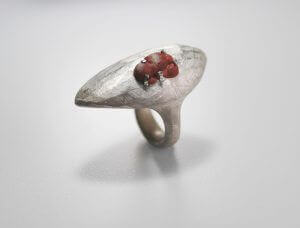



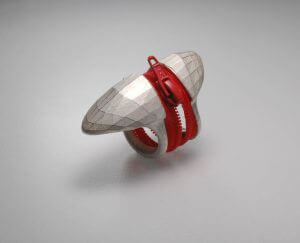

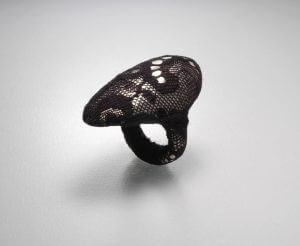




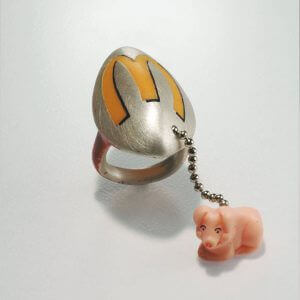
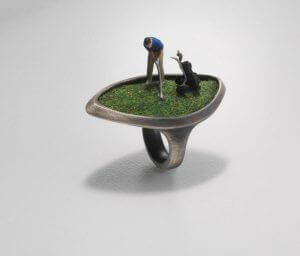











Tell us, what do you think about it